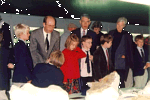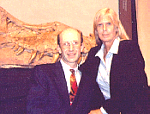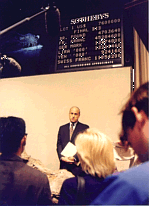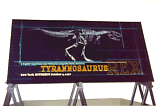"Sue" is a trademark of the Black Hills Institute of Geological Research, Inc.
(click for larger pix)
"Sue" Resources on the Web World
Museum of Natural History
|
At the renowned Sotheby’s auction house
in New York City, on the morning of October 4th, 1997, the world’s greatest Tyrannosaurus
rex skeleton, known as "Sue," fell under the hammer coming in at a stunning
8.36 million dollars. The Field Museum of Natural History in Chicago paid the highest
price ever garnered for a fossil specimen. The fossil was discovered and named after Susan
Hendrickson and excavated and partially prepared by the Black Hills Institute of
Geological Research of Hill City, South Dakota. The T. rex will cost The Field
Museum another half-a-million to a million dollars to complete the preparation work. Auction Day At Sotheby’s, "Sue" was displayed beautifully and the catalog was gorgeous. While Sotheby’s supplied over 300 chairs, the auction room was filled to standing room only. Television cameras lined the back and the entire left side of the room representing every major news organization in the world. Print reporters got front row seats. Some estimates put the number of reporters alone at over 100. Attending the auction were many representatives and friends of the Black Hills Institute of Geological Research, including myself; Susan Hendrickson, "Sue’s" discoverer and namesake; Casey Carmody, a long-time "Sue" advocate and supporter; Kristin Donnan, author of a forthcoming book, T. rex on Trial, a complete story of "Sue" and the surrounding controversy. Donnan is also the wife of Peter Larson, President of the Black Hills Institute. Also attending the auction was Dr. Stanford Adelstein, a prominent South Dakota businessman who came to bid on "Sue" as a partner with the Institute. The bidding started at $500,000 and grew in $100,000 increments. Dr. Adelstein dropped out at $1.2 million. The Luxor Hotel in Las Vegas dropped at $4 million, another group lowered their paddle at $5 million, while a new group came in at $5.3 million. A museum from North Carolina bowed out at $7 million—at which time just a couple of bidders were left. A family in Florida left the bidding at $7.5 million leaving The Field Museum the winning bid at a hammer price of 7.6 million dollars. Sotheby’s buyer’s premium made the grand total $8.36 million. All the top bidders at the auction were either museums or individuals acting for museums, which should bring to a close the argument that museums don’t have the resources to purchase important fossil specimens. "Sue" was sold as "Property of the United States Government held in trust for Maurice Williams, Faith, South Dakota." Williams is the rancher on whose property "Sue" was originally found. His land is within the boundaries of the Cheyenne River Sioux Reservation. Williams, as a Native-American rancher, is allowed to put property in trust with the Federal Government. Because the fossil was sold as part of his trust property, Williams will receive, after commissions and expenses, some 7.5 million dollars—tax free. In a prepared press release, The Field Museum credited sponsors including McDonald’s Corporation, Ronald McDonald House Charities, Walt Disney World Resort, the California State University system and unnamed private individuals for contributing to the purchase. The president of the Field Museum, John McCarter, said the consortium had been working on the purchase since April of this year. "Sue" will be prepared in public in the McDonald’s Fossil Preparatory Laboratory to be developed at The Field Museum. A cast replica of "Sue" will be showcased in Dinoland U.S.A. in Disney’s Animal Kingdom at Disney World in Florida. DinoLand U.S.A. is sponsored by McDonald’s. As part of McDonald’s millennium celebration, two additional life-size casts of "Sue" will travel throughout the United States and around the world. Public preparation of "Sue" will take place at The Field Museum throughout 1998 and 1999 and will be displayed as part of a new exhibit in the year 2000. The curious sponsorship support of the California State University system in the auction brings some concern to researchers. News reports in California say that the university system purchased research rights, a move that adds to worries that access to research on "Sue" could be restricted. The legal battles surrounding "Sue" have already lost 5 years of research time while she was in dead storage. Before the F.B.I seizure of "Sue" in May 1992, the Black Hills Institute had assembled an international team of over 30 scientists to work on "Sue." A major new monograph on Tyrannosaurus rex was to be published by the Institute. At the time, this unprecedented access to "Sue" was applauded throughout the scientific community. After the announcements, press releases and press conferences, television crews and on-lookers left to file their stories, or to enjoy the beautiful day. Susan walked up to the stage where "Sue" now waited for the packing crates and her new home in Chicago. Seven years had passed since Susan first discovered her weathering out of the cliff face. The auction room was empty. Susan touched "Sue’s" massive skull for the last time, saying goodbye to the fossil she brought to the world. "Sue" and the Institute The auction represented a bittersweet end to a bizarre chapter of my life and to the lives of all the people at the Black Hills Institute. The experience of these past five years can be summed up by the Chinese curse; "may you have an interesting life." When Karen Reedstrom asked me to write a story about the auction and how I felt, I didn’t know exactly where to start. Do I start on the summer day when Susan Hendrickson discovered the fossil, spying three vertebrae and pieces of other large bones crumbling out of a cliff face—the moment when she knew she found a T. rex? Or the day "Sue’s" fame exploded around the world—when the FBI, the National Guard and various other federal agencies mounted a three day raid on the Institute and seized her bones while grade-school children protested outside the building? Or how about going over the hundreds of hours I put into preparing "Sue"—slowly extracting the bones from around her skull and the delicate job of separating her huge pelvis from on top of her nose? Or, about the days during the government’s subsequent raids on the Institute for more papers and fossils? Or, when we lost the rights to the "Sue" because Williams didn’t have permission from the government to sell "Sue" to the Institute in the first place? Or how about when we sat through the longest criminal trial in South Dakota History accused of 39 separate crimes against the government? Or perhaps, Pete’s conviction for not filling out forms and his subsequent 18 months in prison would be a better place to begin. All of these thoughts, and more, were going through my mind as the auction day approached. Many times reporters at Sotheby’s asked me, "what single factor makes "Sue" so remarkable?" There are at least three: one, "Sue" is the biggest Tyrannosaurus rex ever found; two, "Sue" is the most complete T. rex ever found; and three, she is the best preserved T. rex ever found. Any one of these three factors would make "Sue" an outstanding fossil, but the combination of these features along with the other incredible stories revealed in her bones makes her a fossil of almost mythic proportions. "Sue’s" epic life is told by her battle-scared bones. Injuries reveal "Sue" fought with other dinosaurs and fossils found around her give us a vision of a world that is as good as the best science fiction story. "Sue" is a scientist’s treasure and a kid’s dream. The combination of the talents of The Field Museum of Natural History with McDonald’s and Walt Disney should make an excellent team to share "Sue’s" story. But it is bittersweet moment for us at the Institute, for we are the ones who brought "Sue" into the world, proved her worth, and paid the price for her discovery. Like "Sue," we carry the scars of battle, but not defeat. The Black Hills Institute of Geological Research has survived the crushing burden of the government’s prosecution and is now moving ahead with its plans to open its own museum, The Black Hills Museum of Natural History. During the trial the Institute continued its work on another T. rex called "Stan" which is now mounted and on display, with hundreds of other fossil and mineral specimens, at its home in Hill City, South Dakota. Watch for two books that will be coming out in 1998. One by Peter Larson that he wrote while in prison called The Tyrants, a story about Tyrannosaurus rex and what we now know about these incredible creatures, the book will include information on the latest T. rex finds. The book T. rex on Trial by Kristin Donnan promises to be an in depth story about this complicated case that culminated with Peter Larson’s imprisonment and the sale of "Sue," the best T. rex ever found. |





